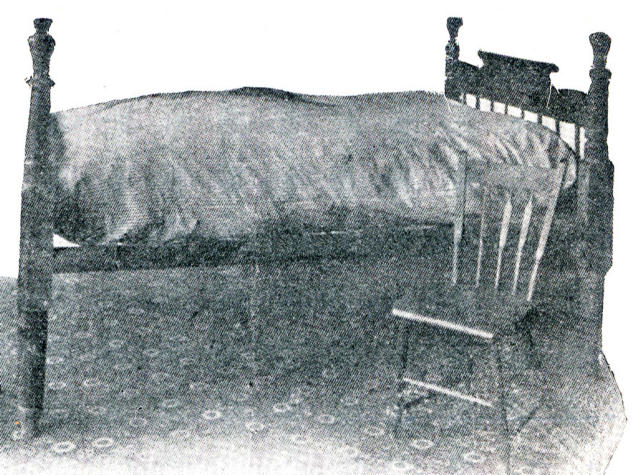
| JOHNSON COUNTY IAGenWeb Project |

|
Storefronts along Clinton Street north of Washington dominate this 1856 view taken while Iowa City was the capitol of Iowa. The space between the taller structures and a two-story white building north (left) of them marks the entrance onto Iowa Avenue east of Old Capitol. This image by noted local photographer Isaac Wetherby has been digitally repaired and enhanced. |

|
This cord bed from Iowa City’s pioneer past was state of the art in the 1840s when it was owned by John Wagner, reports C. Ray Aurner in his 1912 local history. The chair was made by Henry Wieneke, a prominent local merchant, demonstrating the self sufficiency which characterized all pioneers. The image is digitally enhanced. |
|
By Bob Hibbs
Johnson County pioneers were a
hardy lot who
challenged a wilderness with little but their own hands, and not only
persevered, but prospered.
During the late 1830s rude
plows turned virgin
soil and rough cabins sprang up on an otherwise natural landscape
forming the
base for an agricultural society among native peoples on the American
frontier.
Into its midst Iowa City was
created by fiat
of a divided Territorial Legislature acting in desperation to move the
territorial capital out into what all were certain would soon become
another
member of the union of states.
Retired Ohio Gov. Robert Lucas,
who had been
appointed chief executive of Iowa territory by President Martin Van
Buren in
1838, named three Iowa legislators to meet on May 1 in the seat of
Johnson
County called Napoleon to proceed to select a spot for a capital named
Iowa
City.
Dubuque legislator Chauncey
Swan escorted by
local settler Frederick Irish showed up at the designated time and
place,
actually fur trader John Gilbert’s cabin a mile south of what is now
the
southern boundary of Iowa City.
Two other legislators, Robert
Ralston and John
Ronalds, failed to show up, so Swan sent pioneer settler Philip Clark
to fetch
Ronalds from his Wapello area farm before the appointed day expired.
Clark made the 70-mile
roundtrip on horseback
in an era without roads, improbably in the time allotted, but
succeeded, or so
Swan chose to read his watch for the legislative record. Ronalds and
Ralston
were characterized by contemporary locals as traitors to the Iowa City
cause,
believing both wanted the selection to fail so the legislature could
reconsider
its choice.
Swan is considered the founder
of Iowa City
for his work in site selection, layout, lot sales to benefit the
territory and
in commencing construction of Old Capitol. He commemorated the traitors
by
naming a street for Ronalds and a creek for Ralston, but placed his own
name on
nothing. Only a century and a half later was his name attached on a
tiny green
space across Washington Street from City Hall.
Local population grew from 237
in the entire
county in 1838 to an 1840 census of 1,504, then ballooned to 4,472 in
1850 and
17,573 a decade later.
Clinton Street became the first
center of
commerce, facing the statehouse grounds where Old Capitol rose from
native stone
and timber toward an 1842 opening. The territorial legislature first
met in Iowa
City in 1841 in a two-story frame building just east of the
Clinton-Washington
corner. The locals dubbed it “Butler’s Capitol” after Walter Butler who
built it adjoining his hotel which faced Clinton Street.
One of the earliest images of
Iowa City was
made by Isaac Wetherby showing Clinton Street in 1856.
The largest building in that
image is the only
one which still exists, now possibly the oldest surviving downtown
structure. It
is the F.P. Brossart building at 16 S. Clinton St., now occupied by
McDonald
Optical headed by 1980s Iowa City mayor John McDonald.
During the late 19th and
early 20th centuries, the
Namur Bakery made its heralded “snowflake bread” there.
Others, including this reporter
on occasion,
have pointed at 111 and 115 S. Dubuque St. immediately south of the
Jefferson
Hotel building as the oldest survivors downtown. The better preserved
is the
Franklin Printing House at 115 built in 1856 to house the Iowa
Capitol Reporter newspaper.
The Wetherby image suggests the
Brossart
building is at least as old. Some date the Wetherby image to 1854,
rather than
the 1856 date this reporter accepts as correct.
Comforts in pioneer days did
not include beds.
An image taken in one of two pioneer cabins built on the county
fairgrounds by
Old Settlers Association members on Sept. 28, 1889 shows a cord bed
which
screams, “Oh my aching back!” although an accompanying chair looks
comfortable.
These two cabins may be those
in disrepair
which today rest in the upper level of Iowa City Park. Copyright 2003
By Bob Hibbs Bob Hibbs collects local postcards and researches history related to them. |